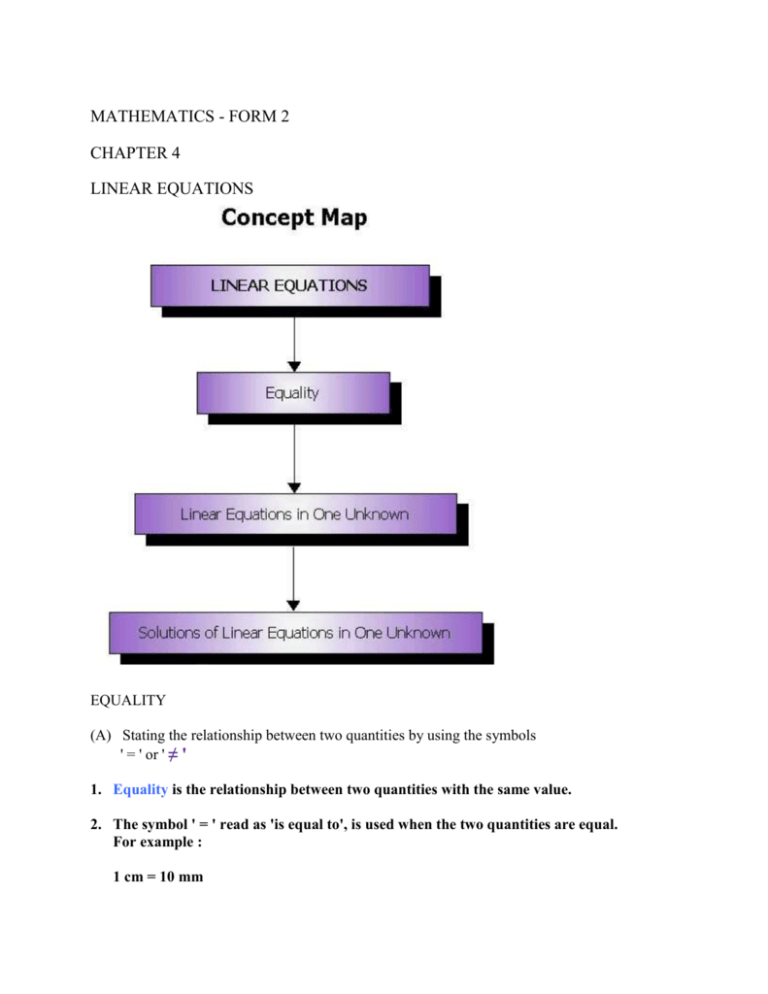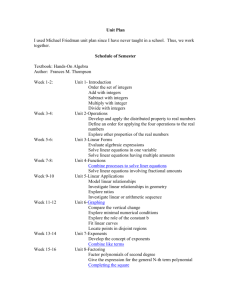Chapter 4 - E
advertisement

MATHEMATICS - FORM 2 CHAPTER 4 LINEAR EQUATIONS EQUALITY (A) Stating the relationship between two quantities by using the symbols ' = ' or ' ≠ ' 1. Equality is the relationship between two quantities with the same value. 2. The symbol ' = ' read as 'is equal to', is used when the two quantities are equal. For example : 1 cm = 10 mm 4 - 2 = 5- 3 3. For two quantities with different values, the symbol used is ' ≠ ', which is read as 'is not equal to'. For example : 4x3 ≠ 4x2 RM1 ≠ 10 sen 4. An equality has two characteristics : (a) Reflective characteristic If a = b, then b = a For example : 10 - 3 = 2 + 5 Thus, 2 + 5 = 10 - 3 (b) Transitive characteristic If a = b and b = c, then a = c For example : 2 x 8 = 16 and 16 = 4 x 4 Thus, 2 x 8 = 4 x 4 LINEAR EQUATIONS IN ONE UNKNOWN (A) Recognizing linear algebraic terms 1. A linear algebraic term is a term with only one unknown raised to the power of 1. For example : 2. If a term has more than one unknown or/and the power of the unknown(s) is greater than one, then, the term is a non-linear algebraic term. For example : (B) Recognizing linear algebraic expressions A linear algebraic expression has one or more linear algebraic terms that are linked by plus or minus sign or both. (C) Determining if a given equation is a linear equation or a linear equation in one unknown 1. An equation must have the symbol ' = '. 2. A linear equation is an equation with one or more linear algebraic terms. For example : (a) 3k + 4s = 10 is a linear equation. (b) 2ab = 5 and c2 - 6 = 1 are not linear equation. 3. A linear equation in one unknown is a linear equation that consists of only one unknown. For example : (D) Writing linear equations in one unknown for given statements and vice versa 1. To solve a problem, we can write the given information as an equation and then solve it. SOLUTIONS OF LINEAR EQUATIONS WITH ONE UNKNOWN (A) Determining if a Numerical Value is a Solution of a Given Linear Equation with One Unknown Solving a linear equation is the process of finding the value of the unknown itn the equation that satisfies or makes the equation true. If we add, subtract, multiply or divide one side of the equation by a number, we must do likewise on the other side of the of the equation. The number that satisfies the eqution is called the solution or root of the equation. A linear equation with one unknown has only one solution. (B) Determining the Solution of a Linear Equation with One Unknown by Trial and Improvement Method The trial and improvement method in determining the solution of a linear equation with one unknown is to quess at a solution and then test it in the equation. If the value satisfies the equation, then it is the solution for the equation. (C) Solving Equations in the Form of x + a = b , where a and b are Integers and x is an Unknown (D) Solving Equations in the Form of x - a = b, where a and b are Integers and x is an Unknown (E) Solving Equations in the Form of ax = b, where a and b are Integers and x is an Unknown (F) Solving Equations in the Form of x = b, where a and b are Integers and x is an Unknown. a (G) Solving Equations in the Form of ax + b = c, where a, b and c are Integers and x is an Unknown (H) Solving Linear Equations with One Unknown (I) Solving Problems Involving Linear Equations with One Unknown When solving a problem involving equation with one unknown, (a) form a linear equation from the statements and information given. (b) solve the equation formed.







